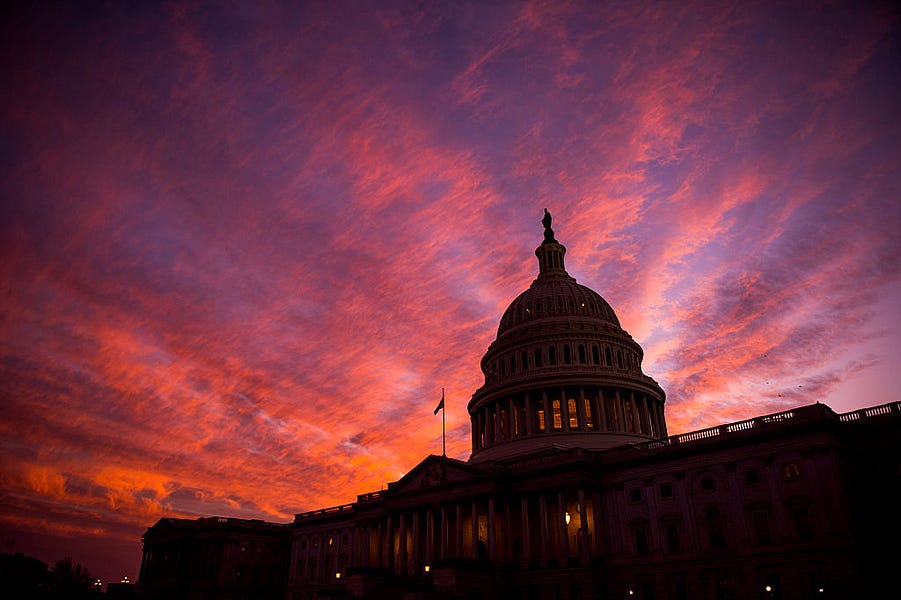George Washington had an uncanny knack for getting things right at the last minute. As general of the Continental Army, Washington defused a conspiracy within his officer corps to revolt at the tail end of the Revolutionary War in the spring of 1783. Such a military revolt could have snuffed out American democracy in its infancy. In his old age, Washington, who had owned slaves since he was a young boy, ensured that all of his slaves would be freed upon his wife Martha’s death through his will.
And on September 17, 1787, the final day of the Constitutional Convention in Philadelphia, Washington came out in favor of reducing the minimum ratio of representation in the House of Representatives from one representative per 40,000 constituents to one per 30,000 constituents. According to James Madison’s notes, Washington broke the silence he had sustained all summer and remarked that “The smallness of the proportion of Representatives had been considered by many members of the Convention an insufficient security for the rights & interests of the people.” Washington concurred; he declared that it would give him “much satisfaction” to see the ratio lowered.
We’ve followed in Washington’s footsteps by warding off military despotism and abolishing slavery, but not in ensuring that the House of Representatives remains representative. Today, the average House member represents more than 700,000 people.
It might seem like it’s overstating matters to place concerns about the size of the House of Representatives alongside core tenets of the American creed like the persistence of constitutional democracy itself and the abolition of slavery. But for many members of the revolutionary generation, the legislature’s size implicated the same fundamental question—the question of self-government.
That’s why, in accordance with Washington’s expressed wishes at the convention, the original First Amendment proposed to the Constitution sought to ensure that the House of Representatives remained representative. Known today as the Congressional Apportionment Amendment (CAA), it would have automatically increased the size of the House as the American population grew and capped the maximum district size at 50,000 constituents. If ratified today, it would create a House with more than 6,000 members.
You probably just scoffed: A 6,000 member House? That’s insane. Is the solution to our problems really more politicians? And where would they all sit, anyways?
While valid, such questions demonstrate just how far our conception of democracy has strayed from the revolutionary generation’s understanding of self-government.
Even with Washington’s representation ratio addendum, most Americans were repulsed by the tiny size of the House of Representatives under the new Constitution. State legislatures at the time were far more representative than the proposed 65-member House. As Harvard law professor Michael Klarman points out in his book The Framers’ Coup, “in 1787, the lower house of the Massachusetts legislature contained 266 delegates, each of whom represented roughly 1,425 state inhabitants.” (Today, each member of the Massachusetts House represents on average 40,000 constituents. The lack of representation isn’t just a federal problem.)
In the state ratifying conventions of 1787-1788, Anti-Federalists in particular lambasted the insufficient representation in the excessively small House. With such large districts, they claimed, representatives would be unfamiliar with the views of their constituents. A smaller House would also be more prone to corruption. Moreover, as Anti-Federalist essay writers like “Brutus” argued, “the feebleness of the representation … will not possess the confidence of the people.” Deprived of a strong representative stake and voice in government, the people will grow detached from it. The execution of the law would have to rely on force rather than “the good opinion” and consent of the people.
The Anti-Federalist critique was so powerful because in the eyes of founding-era Americans, representation, the legitimacy of government, and the protection of individual rights all went hand in hand. Early Americans drew a straight line from the lack of their representation in Parliament to the oppressive taxation and infringements on their liberties by the British. After fighting a costly, risky, bloody war to secure the ability to govern themselves, they reasoned that only government by and of the people—a representative government—provided sound protection to fundamental individual liberties like those now enshrined in the Bill of Rights. As Melancton Smith, an Anti-Federalist delegate to the New York ratifying convention, put it: “We certainly ought to fix, in the Constitution, those things which are essential to liberty. If anything falls under this description, it is the number of the legislature.”
The Federalists did not disagree in principle. As one of the Constitution’s foremost advocates, James Madison was committed to majority rule, and healthy representation aligned with that. This is why, in Federalist No. 55, Madison wrote that the question of the House’s size was especially “worthy of attention.” Madison did caution against an excessively large House, arguing that too crowded a legislature would be chaotic and allow passions to run wild: “In all very numerous assemblies, of whatever characters composed, passion never fails to wrest the sceptre from reason. Had every Athenian citizen been a Socrates; every Athenian assembly would still have been a mob.”
But Madison was too firm a believer in the importance of representation and too shrewd a political operator to leave things there: “the number of representatives will be augmented from time to time in the manner provided by the constitution.” Therefore, Madison concluded, “The true question to be decided … is whether the smallness of the number, as a temporary regulation, be dangerous to the public liberty: Whether sixty five members for a few years, and a hundred or two hundred for a few more, be a safe depositary for a limited and well guarded power of legislating for the United States?” Madison clearly assumed that the House would not be capped permanently at an artificially low number. The ratio of representation would remain fairly constant: The House and the nation it represented would expand alongside one another.
Again acknowledging Anti-Federalist critiques, Madison sought to enshrine that assumption in the Constitution itself when he introduced the CAA on the House floor on June 8, 1789. In doing so, he was making good on his 1789 House campaign pledge to “provide expressly in the Constitution, for the periodical increase of the number of Representatives until the amount shall be entirely satisfactory.” The amendment passed both houses of Congress that September and was sent to the state legislatures for ratification. It came up short of the necessary three-fourths supermajority by one state, although archival evidence unearthed in 2011 indicates that Connecticut may have ratified the amendment after all. Much of the confusion stems from a typo.
Putting the Connecticut controversy aside, the fact remains that the CAA was not officially ratified. But as James Madison predicted in Federalist No. 58, the size of the House did expand as the nation grew, at least early on. But that stopped as the revolutionary generation died off. In fact, in 1840, the size of the House was reduced even as the nation’s population was growing. And in the 1920s, driven in large part by anti-immigrant and anti-democratic sentiments, Congress arbitrarily capped the size of the House at 435 members—where it still stands today, roughly 100 years and 200 million more people later.
Madison assumed that Americans would not stand for an insufficiently small, unrepresentative House. He’s been proven wrong thus far, but there’s no reason we can’t take action now and prove him right.
The Congressional Apportionment Amendment, passed by Congress in 1789, remains open to ratification by the state legislatures. Eleven of them (if we don’t include Connecticut) already ratified it back in the 1790s. So, all we need is 27 more state legislatures to go ahead and ratify it. The ball is not in Congress’s court, thank God, because House members would never opt to dilute their own power.
The core rationale for ratifying the CAA remains the same as it did at the time of the founding: A small, unrepresentative House grows detached from We the People, lacks legitimacy, and provides insufficient protection to our most fundamental rights as citizens.
There are immense divisions in America, running along fraught lines of race, religion, class, and culture. There is also deep resentment and contempt. A larger House will not automatically erase these divisions. But it will provide us with the scaffolding to better cope with them. The only chance we have of navigating our deep differences and immense diversity is by talking to one another. And we’ll have an easier time of doing that—of taking up the burden of self-government—if we minimize the distance that currently stands between us and the halls of power. Drastically expanding the size of the House of Representatives by ratifying the Congressional Apportionment Amendment—the first First Amendment—constitutes a step in the right direction.
In a 6,000-member House, representatives would largely live in and vote from their home districts. They would personally know many of their constituents. They would be accessible. They could win campaigns primarily through knocking on doors.
In a word, these members would be representative.
And in ratifying the CAA, by taking a bold step toward democratizing our democracy, we could remind ourselves that the Constitution is in our hands and the burden of self-government rests on our shoulders. We are not powerless, and sometimes the status quo need not hold.
The Founders themselves understood this. During an August 1789 House floor debate, James Madison remarked, “My idea of the sovereignty of the people is, that the people can change the constitution if they please.” And in a letter to his nephew, Bushrod, not long after the Philadelphia Convention had wrapped up in the fall of 1789, George Washington wrote: “I do not conceive that we are more inspired—have more wisdem [sic]—or possess more virtue than those who will come after us. The power under the Constitution will always be with the people.”
This is still true. We must have faith in our own wisdom and our own virtue—that is, in our capacity to work together and govern ourselves.
Thomas Koenig is a student at Harvard Law School. Follow him on Twitter @thomaskoenig98.






Please note that we at The Dispatch hold ourselves, our work, and our commenters to a higher standard than other places on the internet. We welcome comments that foster genuine debate or discussion—including comments critical of us or our work—but responses that include ad hominem attacks on fellow Dispatch members or are intended to stoke fear and anger may be moderated.
With your membership, you only have the ability to comment on The Morning Dispatch articles. Consider upgrading to join the conversation everywhere.